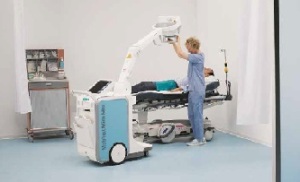by
Lauren Dubinsky, Senior Reporter | November 13, 2015

Siemens’ Mobilett
Mira Max
From the November 2015 issue of HealthCare Business News magazine
Vidant Medical Center in Greenville, North Carolina, has 12 portable X-ray units to serve the 33,000 inpatients and over 266,000 outpatients that come to the facility for acute, intermediate, rehabilitation and outpatient care per year. Four of those units are GE Healthcare’s Optima XR220amx digital radiography (DR) systems.
To determine what kind of productivity benefits they were gaining from the DR systems, Vidant undertook a two-week study. Two technologists were randomly assigned the Optima XR220amx or the AMX-4 computed radiography (CR) system and given batches of six to 10 requisitions every morning shift and individual cases to handle on an ad hoc basis.
The technologists were able to complete batch rounds in half the time, individual cases were sent to the review station three times faster and images were reviewed in real time with three-second average image previews. As a result, the technologists were able to image a greater number of patients. “That immediacy, where people can look at the images and make sure from a QC perspective that they are fine and also make sure the physician is available to look at the patient’s condition, has improved,” says
Sandra Sackrison, radiology system services line administrator at Vidant. “The turnaround time for patient care has really been a satisfier for physicians.”
The benefits of DR
Many facilities are starting to purchase DR systems over CR systems since they don’t require cassettes, generate faster turnaround times and provide better image quality. The University of Vermont Medical Center has four of Philips Healthcare’s DR systems and describes them as a “fixed room on wheels.” “It has definitely increased our productivity tremendously,” says
Carol Kittredge, quality assurance technologist at the University of Vermont Medical Center. “Having the digital screen so we can see the image right away has been a pleaser for many of the physicians in the hospital because then they can review what they need, add more if they need to and then be done at the point.”
The technologists can now image body parts that they traditionally would have moved the patient on a table to image. Kittredge says that other than special functionality like fluoroscopy and tomography, the systems can do everything else that a fixed room can, and also with good image quality.
At last year’s RSNA annual meeting, Siemens Healthcare introduced its new Mobilett Mira Max, which features the DiamondView image processing software that generates images with comparable quality to fixed system images. It also features two new detectors that can be easily swapped between two portable systems or a portable and a fixed system with the MAXswap feature. The MAX mini-detector is 9.5 by 12 inches and the MAX wi-D detector is 14 by 17 inches.
